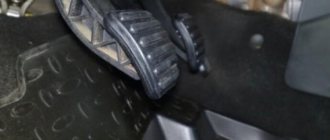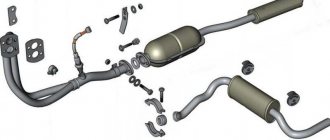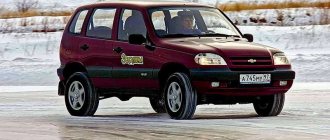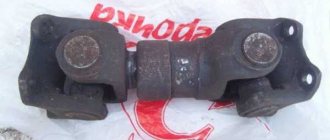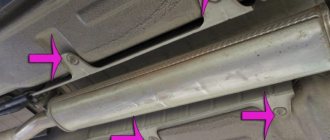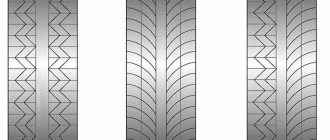The engine force, which is converted into the gearbox, is transmitted to the drive axles of the Chevrolet Niva not directly, but through the transfer case. It performs several functions:
- Distributes torque between axles, allowing them to rotate at different speeds.
- If necessary, it blocks the center differential, preventing wheel slipping.
- Allows you to change the gear ratio, increasing torque.
This key transmission element ensures high maneuverability on difficult road sections.
How to switch the transfer case on a Chevrolet Niva?
Transfer case (TC) is a separate transmission unit of an all-wheel drive vehicle, which distributes power from the engine in different modes to the front and rear axles, which are controlled by the driver. It also enables locking and downshifting using one lever.
The transfer case consists of:
- Brake system,
- draft regulator,
- Gearboxes.
The vehicle is equipped with a two-speed transfer case providing:
- stable movement of the machine when driving at low speeds in high engine speed mode;
- power distribution between drive axles depending on road grip.
The Niva car became the first Soviet SUV with all-wheel drive. A distinctive feature of the car is the center differential locking mechanism. Motorists believe that this mechanism is used to connect the front axle.
see also
Comments 18
If you were steering in 3D and not riding as a passenger, then the principle is the same, only there is one lever on the steering wheel. I switched from Niva to Sh-Niva and no questions arose.
I had 2 fields, then a lot of things now Shng, and in the blog there are a lot of entries that I did myself until I got used to it
Well, with one lever on the RK it’s even easier. I meant the principle of using lowering, raising and blocking.
from the right back - high gear, spins one of the four wheels! from right to front - low gear (for a large hill, sand, swamp, etc.) and also one of four! to the left in the back - increased, the center differential is blocked, both axles are turned (but one wheel from each) to the left in the front - low, well, the same crap as in the line above! I advise you to turn on the lock only when you are stuck! or I'm sure you might get stuck! For everyday driving, do not turn it on even in winter!
From the neutral position to the left downwards the high gear is engaged with the MD locking, the left forward position is engaged in the lower gear and the MD locking, the position to the right up is engaged the lower gear, the right downwards the higher gear is engaged (everyday road conditions)
Read more: ZAZ chance manufacturer country
Between the axle differentials, it’s difficult to turn on and off its locking as described...
Damn, I still don’t understand along the highway to the right down through the mud to the right up and why do the rest
Then, according to the diagram that you wrote in the mud, the car will turn into an underdrive, the torque will not spread to the front axle! The transfer case has the same differential as the axles, so if the rear wheels start to slip, all the torque will go to them and the front wheels will be silent. To prevent this from happening, there is a lock for this differential and then it will be 4x4
oh my god, I think I’m not stupid, I drove a 3D Niva, but I still don’t understand this one, I realized that the track is right back, the track is right forward, it’s dirt and the rest doesn’t fucking understand
Look, in 3D there it is divided into two levers, the small lever is MD locking, the large lever is lowered and higher. Which ones did you use?)
Damn, I still don’t understand along the highway to the right down through the mud to the right up and why do the rest
If the dirt is serious, then turn it up to the left, if everything is not serious, then it will go anyway)
TO THE RIGHT (AWAY) AND BACK - HIGH, RIGHT AND FORWARD - DOWN, RESPECTIVELY. IN THE MIDDLE BETWEEN THEM THERE IS A NEUTRAL POSITION, AND IF FROM THE NEUTRAL POSITION YOU SWITCH TO THE LEFT (TO YOURSELF) AND BACKWARD - HIGH WITH LOCKING AND, ACCORDINGLY, IF TO THE LEFT AND FORWARD, LOWER WITH LOCKING. USUALLY HIGH - LOW IS EASILY TURNED ON, BUT TO MOVE FROM NEUTRAL TO HIGH - LOW WITH LOCKING, YOU NEED TO STOP AND IF IT DOESN’T TURN ON, THEN TURN ON THE REAR AND Slightly LOSEN THE MESH OF THE GEAR TEETH, THEN EC THOUGH - RELEASE THE CLUTCH A LITTLE SO THAT THE GEARS LOOSEN, THEN PRESS THE CLUTCH AND ENGAGE THE LOCK.
thank you, it’s terrible that such information won’t fit, but it’s just that on the highway it turns out you need to RIGHT (AWAY) AND BACKWARD, and in the mud RIGHT AND FORWARD - LOWERED
SO EXACTLY, WELL IN PRINCIPLE, YOU DO NOT NEED TO PUSH THE LEVER AWAY FROM YOURSELF, IT IS ALSO ON THE RIGHT SIDE, BUT IF YOU NEED LOCKING SOMEWHERE, THEN THE SAME THING IS, ONLY THROUGH THE NEUTRAL TO YOURSELF - HIGH-LOW WITH LOCKING.
But what about the blocking, sorry, I’m stupid, the first day I bought a shniva, well, the blog will be full of information
IF LOCKING IS NEEDED SOMEWHERE, THEN DO THE SAME, ONLY THROUGH NEUTRAL TO YOURSELF - HIGH - LOWERED WITH LOCKING. 1 PRESS THE CLUTCH, PLACE THE TRANSFER LEVER IN THE NEUTRAL POSITION. 2 PULL THE LEVER TO YOURSELF (TO THE LEFT) AND TURN ON: BACK - HIGH WITH LOCKING OR FORWARD - LOWER WITH LOCKING. WHEN THE LOCKING IS NO LONGER NEEDED (HAVE LEFT OUT OF A HUGE MUD PUDDLE), THEN IN THE REVERSE ORDER - 1 PRESS THE CLUTCH, PUT THE TRANSFER LEVER IN THE NEUTRAL POSITION. 2 MOVE THE LEVER AWAY FROM YOU (to the RIGHT) AND TURN ON: BACK - HIGH WITHOUT LOCKING (ON THE HIGHWAY OR CITY - NORMAL DRIVING) OR FORWARD - LOWER WITHOUT LOCKING (DIFFICULT AREAS)
Read more:
The Chevrolet NIVA SUV is equipped with a five-speed gearbox, as well as a transfer case with a range and a center differential lock.
When purchasing this car for the first time, the car owner does not always know how to use such a transmission correctly, when and under what conditions it is necessary to engage the lock, and when to lower it.
Chevrolet Niva - transfer case control levers
The main element of the axle locking mechanism is the transfer case. The transfer case is controlled by a six-position lever. On a Chevrolet Niva, switching the transfer case depends on road conditions.
transfer case control levers
To downshift , the lever should be shifted to the right and up. This gear is engaged when the vehicle moves no more than 5 km/h.
This gear is used for minimum speed when overcoming a steep climb or dirt road. It is important that if the car is moving in second or third speed and there is a noticeable obstacle on the road ahead, then it is necessary to stop in advance and shift to a lower gear. This will prevent the clutch from burning out.
To engage an upshift (lock ) - the lever is switched back all the way.
Overdrive is used in the following cases: when driving on rough terrain (where there is a risk of wheel slip), when there is a lack of engine traction, or when driving on a road covered with snow or ice.
Locking at high speed is extremely dangerous, as there is a risk of the car skidding. It is also important that the lock cannot be used if the car is suspended diagonally and the wheel begins to slip on different axles. This is due to the design feature of the gearbox.
Changing gears from low to high is also possible while the vehicle is moving. To do this, depress the clutch twice.
The intermediate position of the lever (neutral gear) completely disables the box, which means that the vehicle cannot be moved
The control lever has the following designations:
- Low (L) - reduction gear (move the lever to the right and up),
- High (H) – overdrive (lever back),
- Neutral (N) – neutral.
You can switch to locking (differential lock) in both high and low gears. To do this, pull the lever to the left until it stops.
The differential is one of the most important elements of the transmission. Its main purpose is to distribute traction force and, if necessary, rotate two consumers at different angular velocities.
Power steering
The car is equipped with power steering, which significantly reduces the force on the steering wheel. If the power steering is not functioning (for example, when towing a vehicle with the engine not running), you can still steer the vehicle, but you will need to apply significantly more force to the steering wheel to do so. In extreme positions of the steering wheel, functional noise is allowed.
Warning
- Do not coast with the engine not running! In this case, the power steering does not work, putting you and other road users at risk.
- It is not allowed to hold the steering wheel in extreme positions for a long time.
On a Chevrolet Niva, switching the transfer case is used as follows
- Lock and reduced speed, activated to overcome mud, slippery slopes or difficult snowy areas.
- Reduced speed with an unlocked differential is activated when overcoming obstacles and inclines on hard surfaces.
- The first speed with the differential unlocked is engaged when driving on a flat road (highway). It is not recommended to use the lock mode on roads with good grip, as this will accelerate tire wear, increase the load on parts and gearboxes and increase fuel consumption.
The operating principle of all-wheel drive (unlocked differential) in a Chevrolet Niva
In normal mode, the Chevrolet Niva operates in high gear with the differential unlocked. Torque is transmitted from the drive through the gearbox and intermediate shaft to a two-speed transfer case. The center differential is built into the transfer case. It connects the front and rear axles and allows them to turn at different speeds depending on road conditions and direction of travel.
How does all-wheel drive work on a Niva with a locked differential?
When all-wheel drive is engaged, both propeller shafts are locked by a locking clutch. This promotes uniform transmission of traction to both axles of the vehicle. Because of this, the vehicle's cross-country ability increases, but controllability deteriorates.
Operating a vehicle in different modes
A lower gear is engaged when it is necessary to increase torque. An example would be driving up a steep slope or driving through sticky ground. To overcome difficult areas, the lock is activated. To achieve a clearer and more fixed engagement, you need to wait for the moment of slipping, and then, with the clutch disengaged, move the lever to the left. While locked, you can only travel a limited distance at a speed of no more than 40 km/h.
Possible problems with the transfer case
To prevent problems with the Republic of Kazakhstan you should:
- control the oil level,
- make sure that the fastenings of the supports are always tightened,
- watch for damage to rubber bands,
- check the condition of the engine and cardan,
- do not change gears while slipping,
- Do not use excessive force if it is difficult to switch the lock.
CHEVROLET NIVA is positioned as a reliable SUV, so its transmission is already prepared for harsh gear changes and aggressive use. The SUV has a five-speed manual transmission, thanks to this function the driver has full control over the movement of the vehicle on slippery roads or off-road.
Transfer case malfunctions
The transfer case is a complex unit, so it is important to correctly diagnose the malfunction and be able to quickly fix it. The most common sign of its incorrect operation is increased vibration. If it is observed when driving in various modes, then the cause may be wear of the elastic coupling. A visual inspection will help verify this. Vibration under direct load (acceleration) indicates a loose attachment of the transfer case to the body, a faulty CV joint on the intermediate shaft, or a jammed joint on one of the cardan shafts. If vibration is observed at a constant speed, then there is a problem with the balancing of the cardan shafts themselves or the differential.
Malfunctions associated with difficult mode switching often occur. Here attention should be paid to the hinges of the control mechanism, as they usually become clogged with dirt. The fork or stem may be deformed. Over time, nicks appear on the splines of hubs and gears. They can be easily removed by grinding, but to identify the defect you have to remove and disassemble the entire assembly.
Preventive maintenance includes timely replacement of transmission lubricant. It is performed every 45,000 km. It is important during operation to follow the rules for switching modes, and also to carefully monitor the timely unlocking of the differential.
The video is not mine, but, as you can hear and see, this problem is not only for.
Chevrolet Niva gearbox operation
We will be grateful if you share with your friends: Other problems Sometimes there is a knocking sound in the transfer case. Turn it down - right up.
Chevrolet Niva › Logbook › Help me figure out the transfer case. everything is simple: in the field there is...
I rebuilt the gearbox - it didn't help. Just today I went to the lake to check if the ice had melted.
That’s why it’s better to do it slowly, at first.
And then he dropped the topic. Maybe this information will also help. I’m not an expert and I’ve never owned a shnivy, Patrick is closer to me. But I am a mechanic of at least 3 categories, and in some cases 4 and 5. Gear whine occurs when the gears are not properly engaged. Google it, adjust it and it won’t howl.
Well, the transfer case needs to be adjusted first. Don't forget to fill it with normal oil. I pour expensive motor oil, I have 11 in the winter, Well, the edge is with a tailwind. The speedometer on the Niva shows the weather on the moon. We're just talking about the short guy! On a slippery road at a speed of 60 or more, you constantly catch the car with the steering wheel.
Short wheelbase, the car constantly shakes. Fortunately, it steers well, but it keeps you tense. The Niva can definitely stupefy the car owner with its cross-country ability and force him to figure out where to get money for this miraculous all-terrain vehicle, which “well, you saw how it rushes! But also, almost every trip to serious off-road conditions forces the Niva owner to figure out where to get money for repairs.
Chevrolet Niva 2006, 80 l. With. - spare parts
In contrast to the suspension, it has a very weak transmission and steering system. Categorically not designed for jerking and shock loads. This increases the load on the transfer case bearings. There is a diagram on the shift lever. To engage a downshift, you need to move the lever to the right, up. To lock the differential, pull it all the way to the left.
There are also Latin letters on the lever. So, L is a low gear, N is neutral, and H is high. Now let's find out how to use all this so that we don't have to repair the mechanism and change the transfer case bearings.
So, if you have to overcome a ford or a puddle, you should stop completely and turn on a lower set of steps. Even at 5 kilometers per hour you will have problems with the transfer case. But you can lock the differential even while driving. This won't bring any surprises.
What is it for?
Unless fuel consumption increases due to the constantly working two axles and axle shafts. In what cases is it necessary to engage a downshift on a Chevrolet Niva? Please note that it should only be enabled when absolutely necessary. Otherwise, the load on the teeth and shafts increases. Forced unlocking Sometimes it happens that the lock gets stuck - it cannot be turned off even when the car is completely stopped.
The situation is quite common for the Chevrolet Niva. To do this, engage reverse gear, accelerate a little and turn off the differential lock while driving.
But if a similar lamp continues to light on your instrument panel, as in the photo below, the lock has not been turned off.
What to do in such a situation? It is necessary to turn on the first speed and try to turn off the unit again. Moving back and forth will solve the problem of a stuck differential. In general, it is recommended to turn on the center lock only in serious off-road conditions.
At the intersection of dirt roads and sand dunes, a downshift is sufficient. Overcoming a deep puddle Often a dispute arises between motorists about how best to cross a ford with a transfer case. You may ask - how long does it take to turn on the blocking and then turn it off? There is another nuance here - very often, many owners of the Chevrolet Niva have a problem with the blocking - it does not turn off.
How to use the transfer case on a Chevrolet Niva? Video review
It just jams and that’s it, you have to drive on the highway with the blockage. This, you understand, is very harmful for the machine and in such cases you must turn it off.
There are several options - turn on reverse, accelerate a little and try to dislodge the lock while driving. You need to do this at speed; it works quite often. Moreover, you can accelerate forward and also try to turn off the lock. I also got stuck once, but even then I didn’t notice it right away and it’s not a problem.
In bright sunny weather it is sometimes difficult to see. Well, about turning off the center wheel - I managed to turn it off just when reversing.
Needless to say, now I turn it on only in the most dire cases. In the rest of the others, lower gears are quite enough for me. Just today I went to the lake to check if the ice had melted.
Why enable blocking?
An SUV is a car that is not afraid of difficulties. Chevy Niva is an all-wheel drive car. The presence of a lock allows it to become an even more powerful and reliable off-road friend. When you turn on the lock, those wheels that are easier to work with work.
When you turn on the lock
As a rule, both axles work at 50%, that is, one wheel on the front axle and one on the rear axle work.
For example, the question of how to use the transfer case on a Chevrolet Niva is relevant when your car begins to slip even when the lock is turned off. In this case, those wheels that are stuck are slipping and as a result they get buried even more. When the lock is turned on, those wheels that have not skidded begin to work and thereby pull the car out of the mud or ice surface.
Eliminate vibration with additional fasteners
Vibration in the body is the main “disease” of the Niva; it often occurs due to improper alignment of the transfer case. Most often, vibration occurs on VAZ 21213/21214 cars, since the transfer case is mounted only on two supports on the sides of the body; on the Chevrolet Niva, the transfer case is already installed on three supports.
- driveshafts are poorly secured;
- wheels are not balanced;
- there is play in the cardan crosspieces (vibration is especially affected by play in the rear driveshaft crosspieces);
- The vibration comes from the engine itself.
Vibration when starting off on a Niva can also occur for the following reasons:
- the mounting supports of the transfer case have become loose;
- The rubber on the RK supports themselves broke.
Installing the third support of the transfer case on VAZ 21213/21214 vehicles allows you to reduce the level of vibration of the transfer case; with this support it is easier to center the transfer case. The part can be purchased at auto stores or made yourself. The finished product comes with three long studs (for model 2121); to install the third support on this machine, you will need to unscrew the short studs from the transfer case housing and install new studs from the kit. We carry out repairs as follows:
- dismantle the front passenger seat in the cabin;
- remove the floor tunnel lining;
- in the cabin we move aside the carpet covering the body amplifier (in front of the handbrake lever);
- remove the transfer case (alternatively, you can simply hang it up, but removing the third support makes it easier to install);
- We attach the bracket of the new support to the body of the RC;
- we install the transfer case in place, center it in the optimal position, and fasten the side supports;
- we combine the third support with the body, drill two holes in the bottom;
- Using washers, bolts and nuts (from the kit) we attach the support to the bottom of the body.
Vibration is eliminated more effectively by installing a subframe under the transfer case. You can also make such a device yourself or buy a finished product at a car store.
In order to install the subframe, the transfer case must be removed. It is more convenient to carry out such work in a pit; we carry out repairs as follows:
- leave the car in neutral gear;
- disconnect the propeller shaft from the transfer case, it is advisable to mark the driveshaft flange and the drive shaft so that during installation, align the driveshaft according to the marks - this way, the occurrence of unnecessary vibrations is eliminated;
- dismantle the muffler mounting bracket;
- remove the gearbox traverse;
- jack up the transfer case, remove the side fastenings of the transfer case;
- We treat the places where the subframe fits to the body with Movil;
- place the subframe on the gearbox studs;
- we mark the attachment points of the subframe on the side members, drill holes, attach bolts to the body;
- we tighten all fastenings, except for the transfer case supports themselves;
- we perform alignment of the steering wheel;
- Finally tighten the transfer case supports.
Also interesting: How to properly use the transfer case on Niva 2121
It should be noted that installing an additional support or subframe on the steering wheel does not always lead to the desired effect; in some cases, vibration only increases.
When to use blocking
Under normal road conditions, you don’t need to turn on anything on the Niva. But on a country road or before a steep climb, the driver should think about safety nets. We have already found out how blocking works on Niva. So you should resort to its help if obstacles arise while driving, and this must be done in advance, before the car gets stuck.
If there is a difficult section ahead, it is best to turn on the blocking in advance, especially since it does not take much time. You just need to remember that using the lock unnecessarily does not contribute to the safety of the car and leads to excessive consumption of gasoline and tire wear.
Overtaking
Yes, comfortable overtaking and the Chevrolet Niva are poorly compatible concepts. An 80-horsepower engine is completely insufficient to perform this maneuver quickly and safely. As you know, overtaking is one of the most dangerous maneuvers and most of the most serious accidents occur during overtaking. The rule “If you’re not sure, don’t overtake” is doubly, if not triple, relevant for the Chevrolet Niva. To tell the truth, after every serious overtaking I still have sweat on my forehead, so I try to overtake only when I am completely convinced that the road ahead is clear and I can drive into oncoming traffic without the risk of not having time to return to my lane. Sometimes you’re driving behind a truck, its driver blinks at you, saying, overtake, thinking that it’s easy for you, but you stubbornly sit behind him, realizing that no matter how hard you try, you won’t be able to make it in time. Sometimes you have to say thank you over the radio and explain that you don’t have enough motor.
When to downshift?
How to use the transfer case on a Chevrolet Niva, why and when to turn on low and lock? This seems like a trivial but serious question. It's simple. Just imagine, you are driving along a country road in fourth gear - the road is wonderful, but then a deep puddle appears in front of you, where, naturally, the road surface is soft and the car will sink. To do this, you need to stop and engage a lower gear. You are not mistaken, but you really need to stop.
The whole reason is that there is a center differential that simply will not allow you to switch from high to low and back. Why do you need a downshift at all?
Just imagine - you need to drive along a soft or heavily polluted section of the road. For example, you are driving in second gear and begin to feel that the car is heavy and something is slowing it down, you switch to first, but it is still hard for it, that’s what a lower gear is for.
The first downshift is like half the first upshift, that is, if you shift to the second downshift, you get the first upshift.
As a rule, low gear is designed for off-road use.
. When the low gear is on, you need to drive and it is advisable not to accelerate sharply, because at this moment the wheels receive a large load and can make a fatal hole that will not allow you to move further.
In this case, the car allows you to feel the movement of the wheels and if they start to dig in, you will immediately understand it by the chaotic movement. In this case, if you notice in time that the car is starting to slip, you can do something to avoid an ambush, for example, change the trajectory.
It is worth paying attention to the fact that if you are driving through deep puddles or sticky mud, then in no case should you sharply switch to the second lower gear, since the car may simply “choke” when the torque increases, which means it will become difficult for it and it will simply stall at the most inopportune moment.
If you are driving, for example, in third gear and feel that the car is becoming heavy, then you should immediately switch to second or even first, so as not to stall in the most dangerous place.
